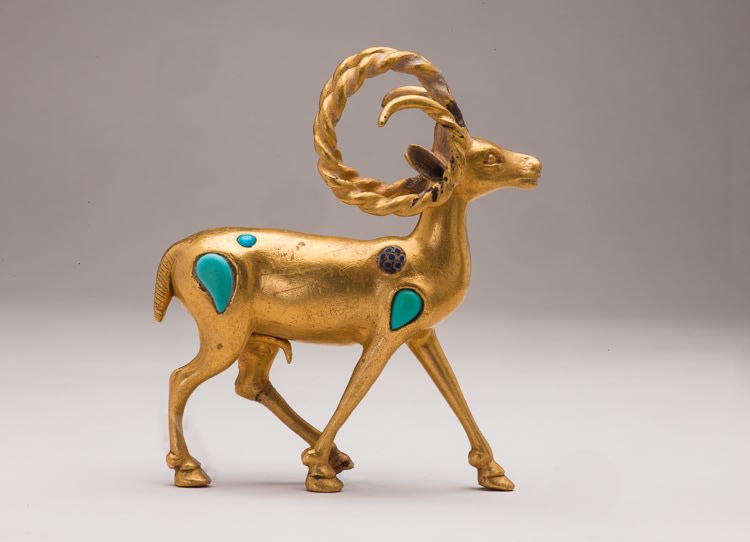Bactrian Figure of an Ibex, 100 BC - AD 100
Gold, Turquoise, Lapis Lazuli
10.8 x 4.6 x 10.3 cm
4 1/4 x 1 3/4 x 4 in
4 1/4 x 1 3/4 x 4 in
LM.51
Further images
This is hollow-cast and presents the animal in general naturalistically, but without details of the coat, and with more curls of the horns that would be expected. the animal is...
This is hollow-cast and presents the animal in general naturalistically, but without details of the coat, and with more curls of the horns that would be expected.
the animal is walking with head up as if sniffing the air.
There are four turquoise inlays, one above each leg, and two round inlays (one now lost) on the rump, of gabbro.
There is a coiled silver necklace around the animal's head and horns, which got attached in the earth when the creature was lost in antiquity.
This comes from West Central Asia and dates to c. 100 B.C. to 100 A.D.
Its style is influenced by both Achaemenid art, and Sarmatian art.
Without the inlays this might easily pass as fine Achaemenid work, but the inlays relate it to Sarmatian work.
A certain stylisation is apparent along with the naturalism.
The tail is marked like a plant shoot, and the male genitals are also stylised. But these features add to the quality of the piece as art.
The nearest comparable statuette was found at Tillya-Tepe in Afghanistan (v. Sarianidi, The Golden Hoard of Bactria, New York, 1958, pgs. 173- 175 and 247), but that is only half of the size of this one.
The Tillya-tepe ibex has more zoological detail, but no inlay and less human appeal.
This is a major work of art from West Central Asia about the turn of centuries, extremely important and of fine quality and state of preservation. Professor W. I. Lambert
the animal is walking with head up as if sniffing the air.
There are four turquoise inlays, one above each leg, and two round inlays (one now lost) on the rump, of gabbro.
There is a coiled silver necklace around the animal's head and horns, which got attached in the earth when the creature was lost in antiquity.
This comes from West Central Asia and dates to c. 100 B.C. to 100 A.D.
Its style is influenced by both Achaemenid art, and Sarmatian art.
Without the inlays this might easily pass as fine Achaemenid work, but the inlays relate it to Sarmatian work.
A certain stylisation is apparent along with the naturalism.
The tail is marked like a plant shoot, and the male genitals are also stylised. But these features add to the quality of the piece as art.
The nearest comparable statuette was found at Tillya-Tepe in Afghanistan (v. Sarianidi, The Golden Hoard of Bactria, New York, 1958, pgs. 173- 175 and 247), but that is only half of the size of this one.
The Tillya-tepe ibex has more zoological detail, but no inlay and less human appeal.
This is a major work of art from West Central Asia about the turn of centuries, extremely important and of fine quality and state of preservation. Professor W. I. Lambert









